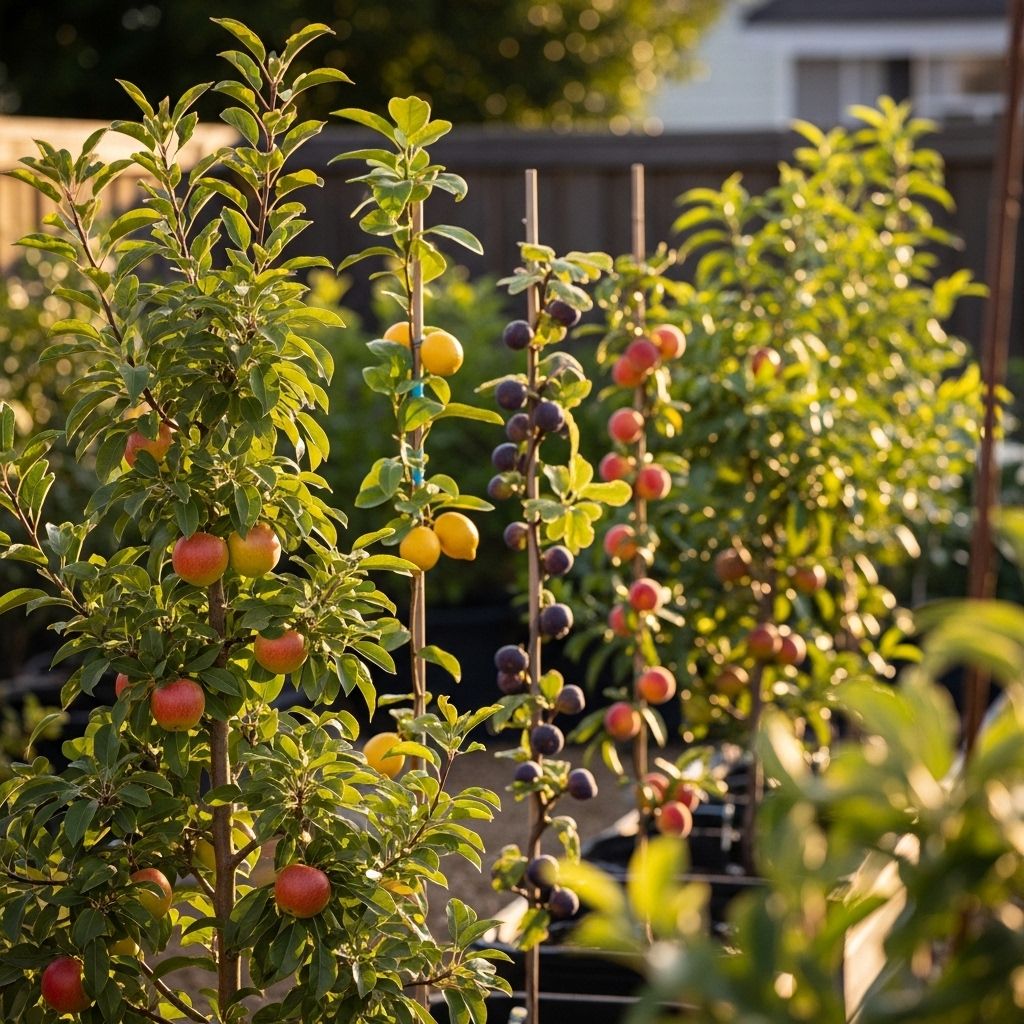How to Start a Mini Backyard Orchard: Your Complete Guide
Turn underused corners into a thriving edible oasis with easy planting and upkeep tips.

Image: HearthJunction Design Team
How to Start Your Own Mini Backyard Orchard
You don’t need acres of land or years of gardening experience to cultivate a thriving fruit oasis in your own yard. A mini backyard orchard provides abundant, homegrown fruit—apples, pears, peaches, citrus, and more—in surprisingly small spaces. Whether you’ve got a 15-by-15-foot patch or a bit more, this comprehensive guide will walk you through the practical steps to design, plant, and maintain your own backyard orchard.
Table of Contents
- Why Start a Backyard Orchard?
- Can You Grow a Mini Orchard in Your Backyard?
- 11 Simple Steps for Planting a Miniature Backyard Orchard
- Maintenance, Pruning, and Care
- Frequently Asked Questions (FAQs)
Why Start a Backyard Orchard?
Growing your own fruit trees offers a bounty of fresh, flavorful fruit right at your doorstep, but the benefits stretch beyond the harvest:
- Variety & Flavor: Enjoy rare or unusual fruit varieties not found in stores.
- Self-Sufficiency: Grow healthy, pesticide-free produce for your family.
- Beauty & Shade: Fruit trees are visually beautiful, attract pollinators, and can provide dappled shade.
- Fun & Learning: Gardening is a rewarding hobby for all ages, encouraging sustainable living and learning.
Can You Grow a Mini Orchard in Your Backyard?
Absolutely! Thanks to dwarf and semi-dwarf varieties, high-density planting, and strategic pruning, even small yards can become highly productive orchards. Here’s what makes it possible:
- Dwarf Varieties: These trees stay smaller, making them easy to manage and harvest.
- High-Density Spacing: Planting trees closer together than in commercial orchards maximizes your space.
- Regular Pruning: Keeps trees healthy, productive, and at a manageable height (typically 6–8 feet).
- Smart Selection: Choosing disease-resistant, climate-appropriate varieties expands your possible harvests.
With as little as a 15×15 foot area, you could fit four to six fruit trees that provide multiple types of fruit throughout the season.
11 Simple Steps for Planting a Miniature Backyard Orchard
Ready to dig in? Here are the essential steps to planning, planting, and nurturing your mini orchard from the ground up.
1. Assess Your Space and Sunlight
Measure your available yard space. Most fruit trees need at least 6–8 hours of direct sun per day for maximum production. Observe your chosen spot throughout the day to ensure it isn’t shaded by buildings or tall trees.
2. Choose the Right Fruit Varieties
- Select fruits you love and that thrive in your climate zone (check with local nurseries).
- Select dwarf or semi-dwarf varieties for compact growth.
- Mix types to spread out harvests (early, mid-season, and late ripening).
- Don’t forget pollination: Some fruits need a compatible pollenizer variety nearby.
Popular backyard choices: Apples, pears, cherries, peaches, nectarines, plums, figs, apricots, citrus, and even berries on bushy shrubs.
3. Design Your Orchard Layout
- Plan for tree spacing: Dwarf trees can be spaced 5–8 feet apart, semi-dwarfs 10–12 feet.
- Stagger trees for airflow and sunlight—avoid straight lines if possible.
- Consider mature tree height to prevent shading neighbors or blocking views.
Tip: Place evergreen citrus on the edges to block noise or unsightly views while maximizing winter sunlight for deciduous trees.
4. Prepare the Soil
- Test your soil’s pH (ideal is 6.0–7.0 for most fruit trees).
- Add compost or aged manure to enrich poor soils.
- Ensure good drainage—fruit trees hate soggy roots!
5. Dig Proper Planting Holes
- Mark out a three-foot diameter circle for each tree (much wider than the root ball).
- Separate topsoil (first 6–12 inches) from subsoil as you dig.
- Widen—not deepen—the hole to help roots spread horizontally, as most tree roots grow outward, not downward.
6. Amend Soil and Fill the Hole
- Mix compost into the topsoil to create a rich planting backfill.
- Refill the hole partially and create a mound if you have heavy clay soil to promote drainage.
7. Place Your Trees
- Remove packaging from the root ball and gently untangle circling roots.
- Set the tree so the root flare is level with or slightly above finished soil grade.
- Fill in with amended topsoil, gently tamping to remove air pockets.
8. Water Thoroughly
- Saturate the root zone after planting—deep, infrequent watering beats shallow daily soaking.
- Use mulch to retain moisture and regulate soil temperature, but keep it a few inches from the trunk.
9. Staking and Protection
- Stake young trees if needed for support, but remove stakes after 1–2 years.
- Install tree guards to protect trunks from rodents and mechanical damage.
10. Initial Pruning
- Trim newly planted trees back to about 24–30 inches tall to encourage low, sturdy branching.
- Remove any broken, dead, or crossing branches.
11. Ongoing Care
- Monitor water needs—especially in the first year as trees establish.
- Apply balanced fertilizer or compost in early spring as growth resumes.
- Prune annually to control height, maximize sunlight, and stimulate vigorous fruiting wood.
- Thin fruit if trees set heavy crops to improve fruit size and prevent limb breakage.
Maintenance, Pruning, and Care
High-density backyard orcharding borrows commercial principles tailored for small spaces and home productivity:
- Prune often: Winter and summer pruning keeps trees small and fruitful. Target 6–8 feet in height for easy harvest.
- Control pests & disease: Monitor for signs of aphids, scale, fruit moths, and disease. Use integrated pest management (IPM) methods whenever possible.
- Feed the soil: Refresh mulch yearly and top-dress with compost. Healthy soil means healthy, resilient trees.
- Water wisely: Deep but infrequent watering strengthens deep roots. Drip irrigation is a great investment for consistent moisture.
Key Benefits of Backyard Orchard Culture
- Harvest a wide variety of fruit in a small planting area.
- Enjoy high-quality fruit ripened on the tree.
- Control tree size for easier maintenance and picking.
- Enhance landscape beauty and biodiversity.
Sample High-Density Planting Table
| Fruit Type | Recommended Spacing | Pollination Notes |
|---|---|---|
| Apple (Dwarf) | 5-8 ft | Most need a second variety |
| Peach/Nectarine | 6-8 ft | Usually self-fertile |
| Pear (Dwarf) | 6-8 ft | Most need a partner for pollination |
| Citrus | 6-10 ft | Self-fertile, evergreen |
| Plum/Cherry | 6-10 ft | Some self-fertile, check label |
Troubleshooting: Common Challenges & Solutions
- Poor Fruit Set: Check for pollinator presence and appropriate variety selection.
- Yellow Leaves: May indicate drainage issues or nutrient deficiencies—check soil and amend as needed.
- Pest Damage: Remove affected fruit, encourage beneficial insects, and use gentle organic controls.
Final Tips for Backyard Orchard Success
- Start small—focus on 3–5 trees for the first year, and expand as you gain experience.
- Record notes about harvest dates, pruning, problems, and success to improve each season.
- Share surplus fruit with friends, neighbors, or local food banks.
Frequently Asked Questions (FAQs)
Q: How many fruit trees can I fit in a 15×15 foot backyard?
A: Using high-density planting with dwarf rootstocks, you can fit 4–6 fruit trees in a 15×15 foot area, with each spaced 5–8 feet apart.
Q: What kind of fruit trees are best for small backyards?
A: Dwarf or semi-dwarf apples, pears, peaches, nectarines, plums, cherries, and citrus. Select based on your climate and local disease resistance.
Q: Do all fruit trees need a pollinator partner?
A: Not all. Apples, pears, and some plums usually require a second variety for cross-pollination, while peaches, nectarines, most citrus, and some cherries are self-fertile.
Q: How do I keep my fruit trees small and manageable?
A: Annual pruning—in winter for structure and in summer to control growth—keeps trees 6–8 feet tall. Use sharp pruners and cut at outward-facing buds.
Q: When is the best time to plant a backyard orchard?
A: Late winter or early spring before new growth begins is ideal, but in mild climates, fall planting can also work for some varieties.
Q: How can I speed up fruit production?
A: Use vigorous, disease-resistant varieties on dwarfing rootstocks, plant in rich, loose soil, and prune properly to encourage fruiting branches. Young trees may bear in 2–4 years.
Start Your Backyard Orchard Journey
Transforming your yard into a lush, productive orchard is a journey—one that pays back year after year with sweet harvests, bursts of spring blossoms, and a deeper connection to your food. With thoughtful planning, proper selection, and attentive care, anyone can enjoy the rewards of fresh fruit from their own mini oasis. Start small, experiment, and savor the flavors of your labor—your backyard orchard adventure awaits!
References
Mini Backyard Orchard Guide: Plant & Prune Dwarf Fruit
Ready to transform your small yard? Watch this video to learn spacing, choosing dwarf fruit varieties, pruning hacks, and space-saving orchard design. Watch now to start growing fresh homegrown fruit!
Read full bio of medha deb












